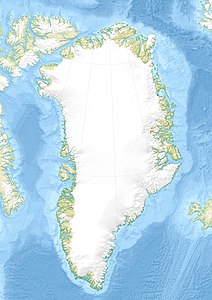Shannon (island)
| Shannon | ||
|---|---|---|
| Waters | Greenland Sea | |
| Geographical location | 75 ° 8 ′ N , 18 ° 24 ′ W | |
|
|
||
| length | 57 km | |
| width | 46 km | |
| surface | 1 259 km² | |
| Highest elevation | Meyerstein Bjerg 305 m |
|
| Residents | uninhabited | |
| Map of the Koldewey expedition | ||
Shannon is a comparatively large island off the east coast of Greenland in the Greenland Sea . Administratively, it belonged to the province of Tunu / Østgrønland ("East Greenland") until the end of 2008 , and since 2009 to the municipality-free area of the Northeast Greenland National Park .
geography
The uninhabited island is 12 km off the east coast of the Hochstetter Foreland peninsula , separated from this by the Shannon Sound , and has an area of 1259 km². It is 57 km long, up to 46 km wide and in Meyerstein Bjerg it reaches a height of 305 m above sea level. Its northernmost point is Cape Børgen ( 75 ° 26 ′ N , 18 ° 3 ′ W ), its southernmost point is Philip Broke ( 74 ° 56 ′ N , 17 ° 37 ′ W ).
South of the island is caused by regular winds, the pack ice of coastal fast ice drift away, one of the largest polynyas East Greenland. Remnants of settlements of the Thule culture in this region indicate that the polynya has been stable for centuries and was used by the Inuit as a hunting ground for seals and whales .
Flora and fauna
The vegetation on Shannon Island is that of a high Arctic tundra . Mammals include collar lemmings , arctic hares , ermines , arctic foxes , reindeer , polar bears and walruses . The number of musk oxen has decreased dramatically in the 20th century. In 1936 the population was estimated at 800 to 1000 animals and in 1976 at 300. From 1988 to 1990, despite an intensive search, only one group of eleven animals was observed.
Birds include the snowy owl , the common raven , the snow bunting , the ptarmigan , the eider , the arctic tern , the sandpiper and various gulls .
history
Was discovered the island in 1823 by British polar explorer Douglas Clavering , who after the HMS Shannon named, a frigate of the Royal Navy , where he previously served as a midshipman was gone. In 1869 the Second German North Polar Expedition under Captain Carl Koldewey reached its northernmost point here. She mapped the island and gave some geographical names such as Cape Børgen, Cape Copeland and Cape Pansch after the expedition members Karl Börgen , Ralph Copeland and Adolf Pansch .
In 1909/10 a search expedition to Ludvig Mylius-Erichsen , the missing leader of the Danmark expedition , spent the winter on Shannon Island. Ejnar Mikkelsen and Iver Iversen (1884–1968) traveled 560 km north across the ice sheet in a dog sledge without finding Mylius-Erichsen. On their return, they found their ship Alabama crushed by the ice and abandoned by the crew. They had to endure two more winters on the island before being picked up by a whaler in July 1912 .
During the Second World War , the German Navy operated a weather station ( company Bassgeiger ) in the northeast of the island at Cape Sussi ( 75 ° 19 ′ N , 17 ° 48 ′ W ) from September 1943 to May 1944 . On October 16, 1944, the weather ship Externsteine was discovered and seized by the US Coast Guard off Cape Børgen .
See also
Individual evidence
- ^ Per Ivar Haug: Gazetteer of Greenland ( Memento June 15, 2011 in the Internet Archive ) , Til Oppslysning . Volume 15. Universitetsbiblioteket i Trondheim, Trondheim 2005. ISBN 82-7113-114-1 (English).
- ^ Meyerstein Bjerg . In: Anthony K. Higgins: Exploration history and place names of northern East Greenland. (= Geological Survey of Denmark and Greenland Bulletin 21, 2010). Copenhagen 2010, ISBN 978-87-7871-292-9 (English), accessed December 28, 2013
- ↑ JBT Pedersen, LH Kaufmann, A. Kroon, BH Jakobsen: The Northeast Greenland Sirius Water Polynya dynamics and variability inferred from satellite imagery. ( Memento of February 2, 2014 in the Internet Archive ) In: Danish Journal of Geography 110, No. 2, 2010, pp. 131–142 (PDF; 3.5 MB; English).
- ↑ D. Boertmann, M. Forchhammer, CR Olesen, P. Aastrup, H. Thing: The Greenland muskox population status 1990 . In: The First Arctic Ungulate Conference , Nuuk, Greenland, 3. – 8. September 1991. (English)
- ^ O. Finsch : Birds . In: Carl Koldewey (Ed.): The second German North Pole voyage in 1869 and 1870 (PDF; 37.0 MB), Vol. 2, Part 1, Zoologie , Brockhaus, Leipzig, 1873
- ↑ J. Georgi : Captain Ejnar Mikkelsen † (PDF; 137 kB). In: Polar Research . Volume 14, 1971, p. 173 f. doi: 10.2312 / polar research.41.1-2.173
- ↑ K. Hassert : Die Polarforschung , Goldmann, Munich 1956, p. 97 f.


